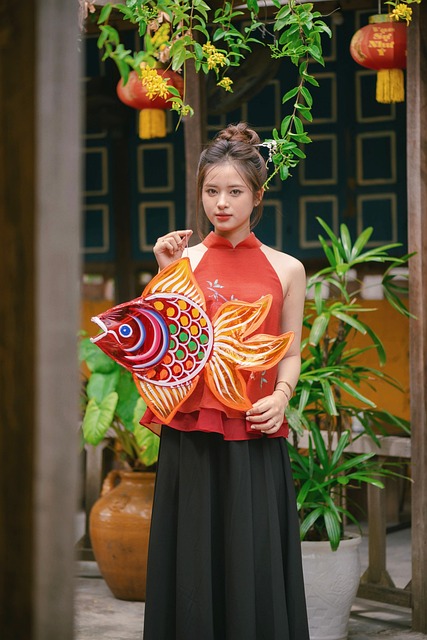Artistic rockwork for fish tanks involves selecting complementary rocks with colors, textures, and sizes for visually appealing formations. Gravel and smaller pebbles add depth while larger boulders serve as focal points. Wood, like treated cedar or pine, brings organic warmth but requires proper cutting and shaping. Balancing asymmetry with negative space creates depth and interest, enhancing aesthetic harmony between rockwork and the tank's ecosystem. Integrating wood elements into hardscaping designs adds texture, warmth, and organic visuals, guiding viewers' eyes through the tank while maintaining ecosystem balance.
Discover the transformative power of hardscaping in aquascaping, specifically focusing on stunning rock and wood formations for your fish tank. Learn how to choose the perfect rocks and woods to enhance your aquatic environment. Explore design principles for creating captivating artistic rockwork, along with techniques for forming and carving unique features. Additionally, discover the aesthetic benefits of integrating wood elements. Elevate your fish tank into a breathtaking underwater masterpiece with these expert tips.
Choosing The Right Rocks And Woods For Your Tank
When creating stunning rock and wood formations for fish tanks, selecting the perfect materials is half the battle won. For artistic rockwork, choose rocks that complement each other in terms of color, texture, and size. Gravel and smaller pebbles can add depth and visual interest, while larger boulders serve as striking focal points. Consider the overall aesthetic you want to achieve—whether it’s a serene mountain stream or an exotic underwater cave—and select materials that align with that theme.
Wood additions bring warmth and organic beauty to your tank. Opt for treated, waterproof wood like cedar or pine to prevent rot and algae growth. Cut and shape the wood to fit your design, ensuring it blends seamlessly with the rockwork. The right combination of rocks and woods can transform a standard aquarium into a captivating underwater landscape that becomes the centerpiece of any room.
Design Principles For Artistic Rockwork
When it comes to creating artistic rockwork for fish tanks, designing with a sense of balance and harmony is paramount. The hardscape should integrate rocks and wood in a way that fosters visual tranquility, mirroring the natural aquatic environment. Utilize the principle of asymmetry, where varying sizes and shapes of rocks are arranged in an informal yet balanced manner, mimicking nature’s unpredictable beauty. This technique adds depth and interest to your tank, providing a captivating backdrop for fish and plants.
Furthermore, consider the concept of negative space, allowing areas around and between the hardscape elements to create their own visual appeal. This balance between solid and empty spaces enhances the overall artistic effect, ensuring your rockwork is not only striking but also harmonious with the tank’s ecosystem. Incorporating these design principles will result in stunning artistic rockwork that elevates the beauty of your fish tank.
Techniques For Forming And Carving Rock Features
Creating dramatic and natural-looking rock formations in both indoor and outdoor settings is an art form known as hardscaping. When it comes to forming and carving rock features, several techniques can be employed for that artistic rockwork. One popular method involves using specialized tools to sculpt and shape individual rocks or stone blocks into desired shapes. This technique allows for intricate designs, from realistic mountain peaks to abstract, organic forms. Carvers can also work with smaller stones and pebbles to construct stacked rock walls or create texture through layering and arranging them in varying sizes.
For those aiming to incorporate artistic rockwork in aquariums (specifically for fish tanks), a similar approach can be taken. Rock formations can be meticulously carved to suit the desired landscape, providing both an aesthetically pleasing environment for aquatic life and hiding spots for fish. This level of detail can transform a standard aquarium into a miniature underwater oasis, complete with cascading waterfalls or dramatic cliff faces.
Integrating Wood Elements For Enhanced Aesthetics
Integrating wood elements into hardscaping designs can dramatically enhance the aesthetic appeal, creating a harmonious blend of nature and artistry. For aquascapers looking to elevate their artistic rockwork for fish tanks, incorporating wooden features like logs, branches, or crafted wood pieces offers a unique dimension. These natural materials introduce texture, warmth, and organic visuals that complement the rigidity of stone structures, resulting in captivating underwater landscapes.
By strategically placing wood elements, you can achieve striking contrasts and interesting visual pathways, drawing the viewer’s eye through the tank. Wood also serves as a versatile medium for creative designs, from intricate carvings to rustic piles, allowing for personalized artistic expressions while maintaining the overall balance of the aquatic ecosystem.
Hardscaping techniques, such as artistic rockwork and wood integration, elevate fish tank aesthetics to new depths. By carefully selecting materials and applying design principles, hobbyists can create stunning underwater landscapes that captivate and inspire. Mastering these skills opens doors to crafting vibrant, harmonious environments for aquatic life, transforming ordinary tanks into extraordinary sea-like realms. For those seeking to dive deeper into the art of artistic rockwork for fish tanks, the possibilities are truly boundless.
